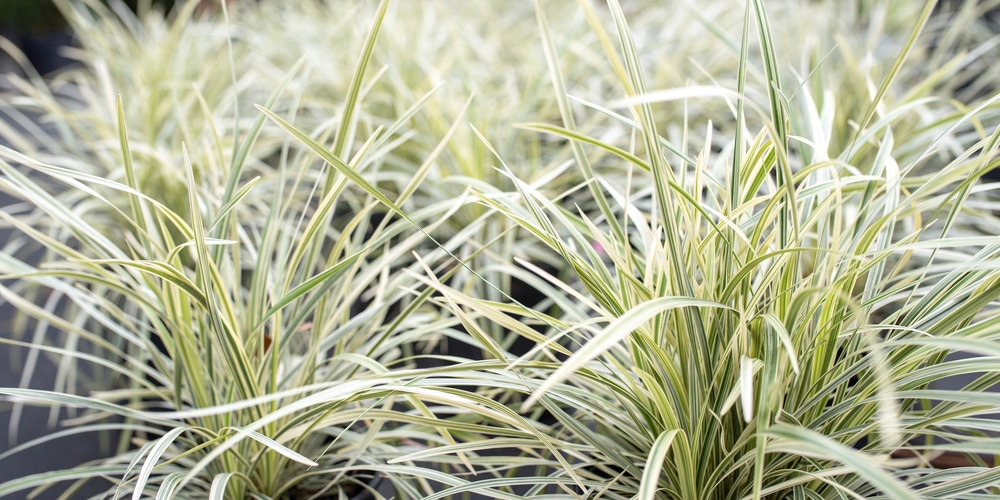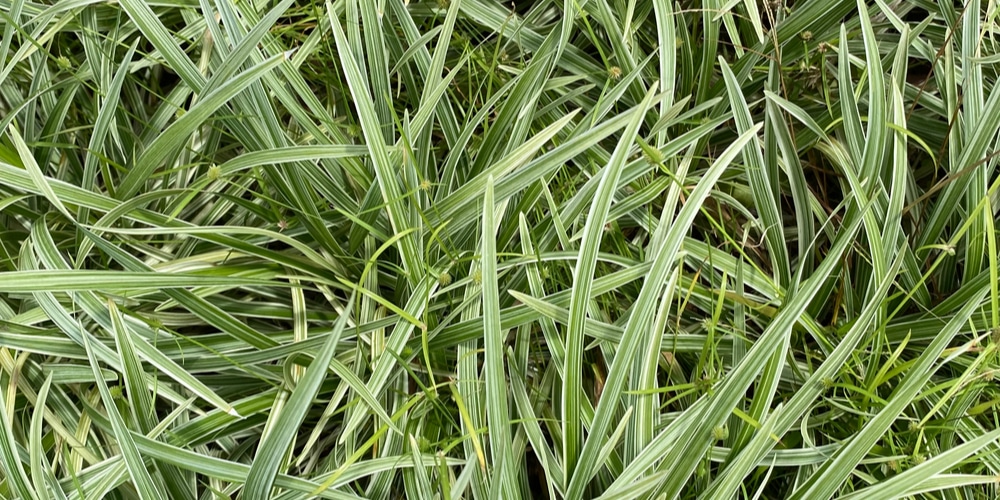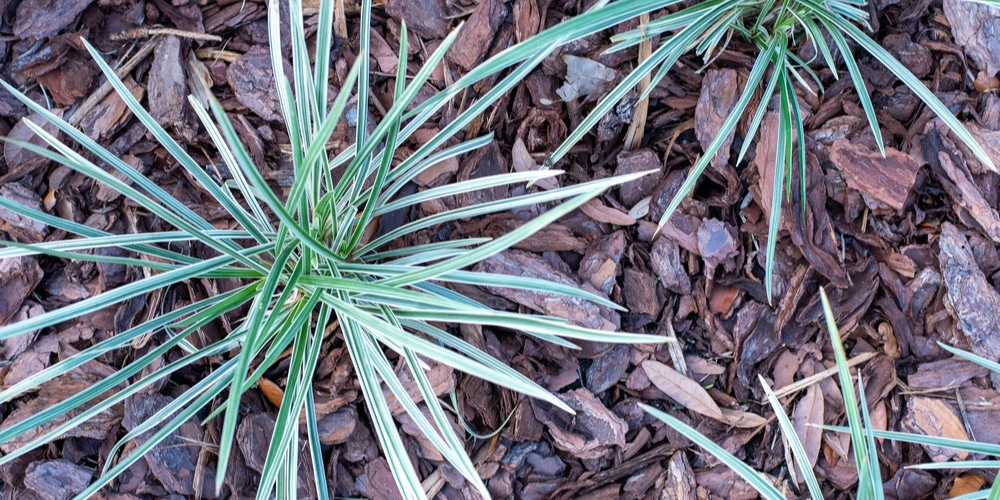Are you looking for an ornamental evergreen grass to use as a groundcover in your yard? Aztec Grass might be your best option, especially if you live in the warmer regions of the country.
This eye-catching plant is perfect for growing anywhere between USDA hardiness zones 7 and 11. With its silvery-green mat and the flowers it produces in the summer, this turf can add an elegant touch to any location.
And the good news is that it is relatively easy to grow, provided that you give it what it needs to thrive. If you want to learn more about the subject, keep reading this essential guide!
| Botanical Name | Ophiopogon intermedium |
| Common Name | Aztec Grass |
| Plant Type | Perennial |
| Flower Color | The plant produces spikes of small white flowers in the summer. The blooms are not flashy, but they stand out in the silvery green foliage. Black-colored berries will follow the appearance of flowers in late summer. |
| Size When Mature | Around 12 inches tall and 12 to 15 inches wide. |
| Bloom Time | Late summer |
| Sun Requirements | Partial sun: ideally, this plant shouldn’t receive more than 4 to 6 hours of direct sun. |
| USDA Hardiness Zones | Between 7 and 11 |
| Soil PH Range | Neutral to Alkaline: from 6.0 to 7.0 |
| Soil Type | Well-draining, moist, and fertile |
| Water Needs | Medium: it should get at least one inch of water (or more) per week. |
| Native Area | Asia |
What you Need to Know About Aztec Grass

Many homeowners appreciate Aztec Grass for its dense clumping qualities. This species is part of the Green Mondo Grasses and contributes to adding an elegant touch to any outdoor space.
After all, its attractive color and texture make it an excellent ground cover, and more so when grouped in a mass planting. Indeed, the Aztec Grass aesthetics is better when planted in groups.
Under the ideal growing conditions, this plant forms a thick and attractive cushion turf with evergreen foliage.
There is some confusion about Aztec Grass, which many exchange for Liriope. But contrary to the “Aztec Grass Lily Turf,” this variety has variegated leaves and produces white flowers (instead of purple).
This plant is cold-hardy and a moderate grower, perfect for rock gardens and borders.
While the Aztec Grass isn’t severely toxic to pets, it might cause vomiting in dogs due to the presence of a toxic called saponins, which can harm these animals’ digestive systems. Keep that in mind if you have dogs running around your garden.
How to Care for Aztec Grass
But what should you know about keeping a thriving Aztec Grass in your garden? And what can you do to recreate the ideal conditions for its growth? Jump to the following sections to find out!
Light
These plants do best in partial shade, especially in hot and dry regions. Ideally, it shouldn’t get more than 4 to 6 hours of sun per day, as too much lighting might burn and cause discoloration to its elegant leaves.
If you can’t offer your Aztec Grass partial shade, you can plant it under the full sun, but on one condition: that you keep it moist at all times. Adding a layer of mulch can help you with water retention and will contribute to regulating the soil temperature.
Water and Soil Needs
You should regularly water your Aztec Grass without overdoing it. These plants don’t like soggy soils and might become susceptible to diseases and fungal infections when the environments are too wet.
Water your plants at least once a week (you may have to increase the frequency if you live in a hot region where summer temperatures are extreme).
Also, adjust your watering schedule to your local climate: if it rains a lot where you live, you might not have to add extra moisture.
To prevent severe issues, you must choose a well-draining potting mix or amend your soil to make it less compact and increase drainage. Adding organic material such as compost or manure can help improve the ground’s texture.
The Aztec Grass will tolerate sandy soils better than other plants and will not suffer short periods of drought.
We always recommend doing a soil test before altering the ground’s composition. Ideally, the pH level to grow this plant should be around 6.0 and 7.0. These plants prefer basic to alkaline environments.
Temperature Requirements
This plant does well in the warmest parts of the country. It is a popular turf in Florida and California. Because of its characteristics, the Aztec Grass thrives between USDA hardiness zones 7 and 11. However, it is also cold-hardy, meaning you can try your luck at growing it even if you live in a region where temperatures are milder.
Fertilizer
We recommend you fertilize your plant during the growing season to enhance its looks. Do it every month between spring and summer. Use an all-purpose, slow-release fertilizer for best results.
And don’t forget to follow the instructions you find on the label. Avoid overusing any synthetic fertilizer: you will cause more harm than good! Instead, consider mowing the grass in late winter to revitalize your plant each year.
Common Diseases
Aztec grass is a relatively low-maintenance plant with few problems with pests and diseases once it establishes itself in a new environment.
One of the few diseases that might bother this plant is a leaf-spotting fungus that might destroy your Aztec grass’s leaves during dormancy. To contain the infection, remove the damaged leaves and rake the bed.
Plus, change the mulch periodically to prevent the appearance of fungi in the soil. It will also keep other weeds at bay. Finally, consider switching to a drip irrigation system or commit to watering your Aztec Grass from below with a hose early in the morning.
Doing so will allow the sun to dry its leaves quickly and prevent the appearance of the disease.
Aztec Grass Propagation
You can propagate your Aztec grass by division to enjoy this plant for longer. You might need to divide your plant every few years. Usually, when you notice dead patches in the center or your plant’s failure to produce thick leaves, it is time to keep your Aztec Grass alive by propagating its volunteer plants.
Dig up your plant during late fall or early winter and cut it into a few sections using sterile shears. Replant the cuttings immediately and keep them moist to increase their chances of adapting to the new environment.
Related Article: What Temperature Does Grass Stop Growing in Summer?

